INTRODUCTION
Extreme windstorms, such as hurricanes and tornadoes, can pose a serious threat to buildings and their occupants in many parts of the country. Hurricanes and tornadoes produce wind pressures and generate flying debris at much higher levels than those used to design most commercial and residential buildings. Hence, these storms require residents to either evacuate the area or seek protection in dedicated shelters. Storm shelters are buildings, or parts of buildings, that are designed and built specifically to provide a highly protected space where community members or occupants can seek refuge during these events.
The newly-developed standard ICC-500, Standard on the Design and Construction of Storm Shelters (ref. 1), provides design and construction requirements for hurricane and tornado shelters. The standard covers structural design requirements for these shelters, as well as requirements for ventilation, lighting, sanitation, egress and fire safety.
ICC-500 covers both hurricane and tornado shelters, and includes requirements for two types of shelters: community shelters, buildings specifically dedicated to provide shelter during a storm; and residential shelters, which are typically reinforced rooms within a home, where the occupants can safely seek refuge during a hurricane or tornado.
Prior to the publication of ICC-500, builders and homeowners seeking storm shelter guidance have used the FEMA 320 publication Taking Shelter From the Storm: Building a Safe Room Inside Your House, and the FEMA 361 publication Design and Construction Guidance for Community Shelters, (refs. 2, 3). Research performed at the Texas Tech University Wind Science and Engineering Research Center (ref. 4), however, found that the FEMA recommendations were overly conservative for concrete masonry for impact resistance. Concrete masonry walls have been tested to withstand the ICC500 criteria, resulting in more economical wall designs than those previously recommended by FEMA.
TEK 05-11, Residential Details for High-Wind Areas (ref. 5), provides prescriptive requirements for reinforced concrete masonry homes in hurricane-prone areas, based primarily on providing a continuous load path from roof to foundation. These are general residential details, and do not address storm shelters. In contrast, the requirements described in this TEK apply only to dedicated shelters, or to shelter areas within a home, meant to provide temporary protection during a storm. Concrete masonry walls capable of meeting the ICC-500 requirements are presented, as well as the results of impact testing on concrete masonry walls. Note that this TEK does not address all requirements of ICC-500.
ICC-500 WIND DESIGN CRITERIA FOR SAFE ROOM WALLS AND FLOORS
General design considerations for storm shelters include:
- adequate wall and roof anchorage to resist overturning and uplift,
- walls and ceiling, as well as openings such as doors and windows, must withstand design wind pressures and resist penetration by windborne objects and falling debris, and
- connections between building elements must be strong enough to resist the design wind loads. Figure 2 shows a typical detail for connecting a concrete roof slab to concrete masonry shelter walls, using reinforcing bars to provide adequate load transfer. ICC-500 defines design tornado wind speeds across the United States, and hurricane design wind speeds for applicable coastal areas. When the shelter is to provide shelter from both hurricanes and tornadoes, the most restrictive of the two design criteria should be used for design. The reader is referred to the standard (ref. 1) for maps defining these speeds. Note that wind speeds in ICC-500 are much higher than wind speeds in ASCE7 (ref. 6) or the International Building Code (refs. 7, 8), and are considered to provide the maximum or ultimate tornado or hurricane design wind speed at a site. Therefore, the wind load contribution in the load combinations is adjusted accordingly.
For example, 1.0W rather than 1.6 W is used as the factored wind load in strength design combinations. In allowable stress design, 0.6W is used instead of W. Wind pressures are to be based on exposure C, although exposure B is permitted if it exists for all wind directions.
In addition to being designed for these design wind speeds, shelter walls and ceilings must be able to withstand impact from flying debris, whose projectile speed varies with the design wind speed. The ICC 500 design criteria vary with location. The concrete masonry walls tested at Texas Tech were tested at the most stringent of the ICC-500 wind speeds and impact requirements, as follows. For tornado shelters, the highest design wind speed prescribed by ICC-500 is 250 mph (402 km/h). Corresponding walls and ceilings must withstand impact from a 15 lb (6.8 kg) wooden 2 x 4, propelled at 100 mph (161 km/h) and 67 mph (108 km/h), respectively.
These conditions will more than satisfy the less stringent requirements for hurricane shelters. For hurricane shelters, the highest design wind speed in ICC-500 is 237 mph (381 km/h) (with the exception of Guam, which has a design hurricane wind speed of 256 mph (412 km/h)). In addition, walls subject to this 237 mph (381 km/h) design wind speed must be capable of withstanding impact from a 9 lb (4.1 kg) wooden 2 x 4 propelled at 100 mph (161 km/h). Ceilings and other horizontal surfaces must withstand impact from the same projectile propelled a 25 mph (40 km/h).
In addition to these requirements, ICC-500 defines requirements for tie-down to the foundation and adequate foundation sizing to resist the design overturning and uplift forces.
CONCRETE MASONRY ASSEMBLIES FOR STORM SHELTERS
A typical concrete masonry storm shelter design is shown in Figure 1. Several concrete masonry systems have been successfully tested to withstand the 15 lb (6.8 kg) 2 x 4 propelled at 100 mph (161 km/h) (ref. 4). Solidly grouted 8-in. (203-mm) concrete masonry walls with No. 5 (M #16) reinforcement at 48 in. (1,219 mm) o.c., with one horizontal No. 5 (M#16) min. at the top of the wall and in the footing or bottom of the wall, can withstand these conditions. All weight classes of concrete masonry meet the strength and impact-resistance requirements. The engineer will use the masonry weight in the shelter design to resist overturning. Regardless of the concrete masonry density, the weight of the grouted masonry assembly provides increased overturning resistance compared to low-mass systems.
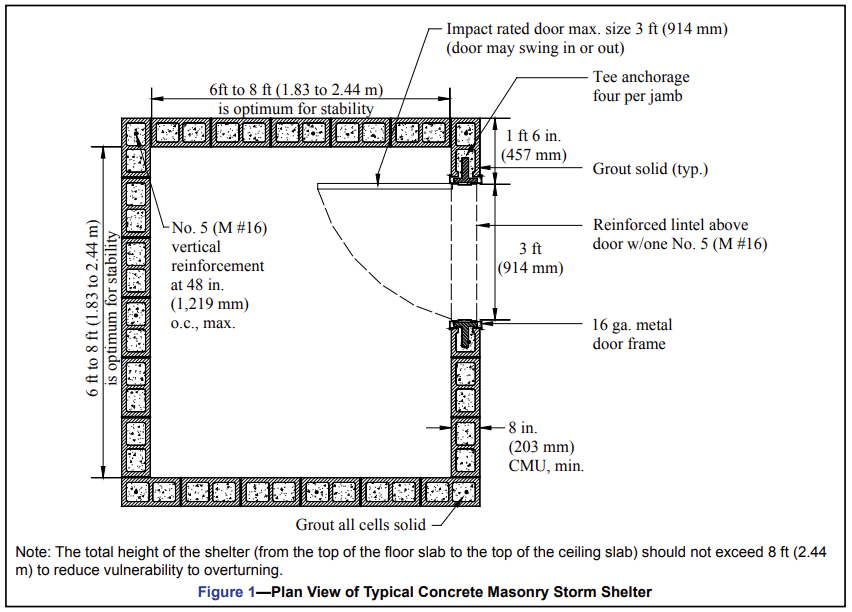
Although solidly grouted 6-in. (152-mm) concrete masonry walls with No. 4 (M #13) bars at 32 in. (813 mm) o.c. successfully passed the impact test, they may not have enough weight to resist overturning for the most severe tornado loading, based on a 250 mph (402 km/h) wind speed. Hence, the details included in this TEK show 8-in. (203 mm) storm shelter walls. Solidly grouted 6-in. (152-mm) walls may be adequate for lower wind requirements, however.
A ceiling system using 7-in. (178-mm) deep bottom chord bearing steel joists infilled with concrete masonry units and grout to a nominal 8-in. (203-mm) depth was also tested and found to withstand the 15 lb (6.8 kg) 2 x 4 at 67 mph (108 km/h) protocol (ref. 4). No. 4 (M #13) reinforcing bars were placed perpendicular to the joists, at 8 in. (203 mm) o.c. Note that all assemblies were successfully tested using standard masonry grout per ASTM C 476 (ref. 9). Some previous references recommend the use of concrete to fill the masonry cores, rather than grout, but this is contrary to the building code and is highly discouraged.
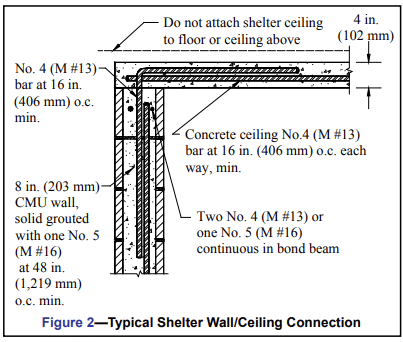
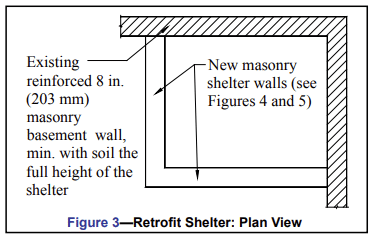
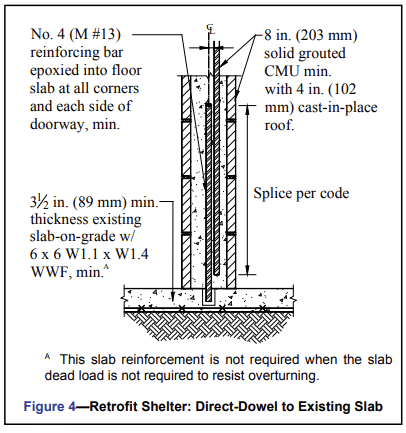
RESIDENTIAL SHELTERS
The purpose of an in-home shelter is to provide an area where the occupants can safely shelter during a high wind event. In flood prone areas, the shelter must not be built where it can be flooded. The shelter should be accessible from all areas of the house and should be free of clutter to provide immediate shelter. If not within the residence, the shelter needs to be within 150 ft (45.72 m) of the residence (ref. 1). FEMA (ref. 2) suggests a basement, an interior room on the first floor on a foundation extending to the ground or on top of a concrete slab-on-grade foundation or garage floor as good locations for an in-home shelter.
Below-ground safe rooms provide the greatest protection, as long as they are designed to remain dry during the heavy rains that often accompany severe windstorms. When shelters are located below grade, the soil surrounding the walls can be considered as protection from flying debris during a high wind event, as long as the wall is completely below grade and soil extends at least 3 ft (914 mm) away from the wall, with a slope no greater than two inches per foot (167 mm/m) for that 3 ft (914 mm) distance. When these conditions are met, the walls do not need to meet the missile impact requirements described above. Below-grade ceilings must have a minimum of 12 in. (305-mm) of soil cover to be exempt from the impact testing requirements.
Sections of either interior or exterior residence walls that are used as walls of the safe room must be separated from the structure of the residence so that failure of the residence, which is designed for a much lower loading, will not result in a failure of the safe room.
RESIDENTIAL RETROFIT
Special consideration must be given when retrofitting a shelter into an existing home. Figures 3 through 5 illustrate typical details for connecting shelter elements to an existing basement wall.
The results of recent testing (ref. 4) has improved the economy of constructing retrofits. Previously, a concrete masonry storm shelter would have required a large dedicated foundation. Research confirms, however, that considering the weight of fully grouted concrete masonry, a large foundation is not required to adequately resist the uplift and overturning forces.
Accordingly, ICC-500 allows concrete masonry storm shelters to be constructed within one and two family dwellings on existing slabs on grade without a dedicated foundation, under the following conditions:
- the calculated soil pressure under the slab supporting the storm shelter walls does not exceed 2,000 psf (95.8 kPa) for design loads other than the design storm events and 3,000 psf (143.6 kPa) for design storm shelter events,
- at a minimum, the storm shelter is anchored to the slab at each corner of the structure and on each side of the doorway opening (see Figure 4), and
- the ICC-500 slab reinforcement requirements are waived if the slab dead load is not required to resist overturning.
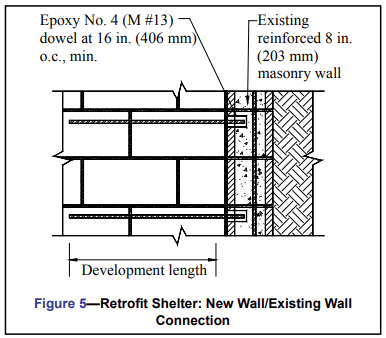
COMMUNITY SHELTERS
Requirements for community shelters are similar to those for residential, but require a larger area and additional features in anticipation of sheltering more people. For example, community storm shelters require: signage to direct occupants to storm shelter areas; wall, floor and ceiling assemblies with a minimum 2-hour fire resistance rating; as well as additional ventilation and sanitation facilities.
REFERENCES
- Standard on the Design and Construction of Storm Shelters, ICC-500. International Code Council and National Storm Shelter Association, 2008.
- Taking Shelter From the Storm: Building a Safe Room Inside Your House, FEMA 320. Federal Emergency Management Agency, 2004.
- Design and Construction Guidance for Community Shelters, FEMA 361. Federal Emergency Management Agency, 2000.
- Investigation of Wind Projectile Resistance of Concrete Masonry Walls and Ceiling Panels with Wide Spaced reinforcement for Above Ground Shelters, CMHA Publication MR 21. Texas Tech University Wind Science and Engineering Research Center, 2003.
- Residential Details for High-Wind Areas, TEK 05-11, Concrete Masonry & Hardscapes Association, 2003.
- Minimum Design Loads for Buildings and Other Structures, ASCE 7-02 and ASCE 7-05. American Society of Civil Engineers, 2002 and 2005.
- 2003 International Building Code. International Code Council, 2003.
- 2006 International Building Code. International Code Council, 2006.
- Standard Specification for Grout for Masonry, ASTM C 476-07. ASTM International, Inc., 2007.
